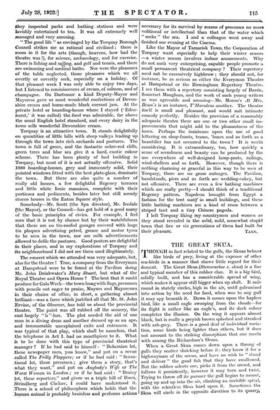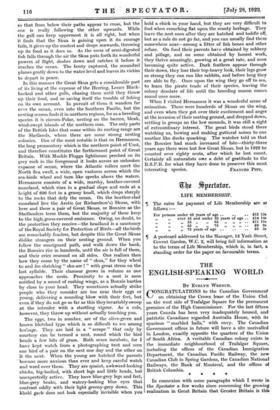THE GREAT 'SKUA.
THOUGH in fact related to the, gulls, the Skuas behave like birds of prey, living at the expense of other sea-birds in a manner that shows little regard for their descent. The Great Skua (Stereorarius s. skua) is a fine and typical member of this robber clan. It is a big bird, solidly built, and has a considerable spread of wing, which makes it appear still bigger when up aloft. It sails round in stately circles, high in the air, until galvanized into action by the need for food, when woe to any gull it may spy beneath it. Down it comes upon the hapless bird, like a small eagle swooping from the clouds—for its flight is rather like an eagle's, and its dark colour completes the illusion. On the wing it appears almost black, but is really a greyish brown splashed and streaked with ash-grey. There is a good deal of individual varia- tion, some birds being lighter than others, but it does not amount to the striking dimorphism that one meets with among the Richardson's Skuas. When a Great Skua comes down upon a throng of gulls they scatter shrieking before it : they know it for a highwayman of the ocean, and have no wish to " stand and deliver " the good fish that they have swallowed. But the robber selects one, picks it from the crowd, and follows it persistently, however it may turn and twist. Trying to throw off its pursuer the gull begins to mount, going up and up into the air, climbing an invisible spiral, with the relentless Skua hard upon it. Sometimes the Skua will circle in the opposite direction to its quarry, so that from below their paths appear to cross, but the one is really following the other upwards. While the gull can keep uppermost it is all right, but when it finds that the Skua is gaining upon it its courage fails, it gives up the contest and drops seawards, throwing up its food as it does so. As the mess of semi-digested fish falls through the air the Skua puts forth its wonderful powers of flight, dashes down and catches it before it reaches the ocean. The booty captured, the scoundrel planes gently down to the water level and leaves its victim to depart in peace.
In this manner the Great Skua gets a considerable part of its living at the expense of the Herring, Lesser Black- backed and other gulls, chasing them until they throw up their food, and so saving itself the trouble of fishing on its own account. In pursuit of them it wanders far over the ocean, even into the Southern Pacific, but the nesting season finds it in northern regions, for as a breeding species it is circum-Polar, nesting on the barren, bleak, wind-swept islands of the northern seas. The only parts of the British Isles that come within its nesting range are the Shetlands, where there are some strong nesting colonies. One of the most notable is that on Hermaness, the long promontory which is the northern point of Unst, and therefore constitutes the furthermost point of Great Britain. With Muckle Flugga lighthouse perched on its grey rock in the foreground it looks across an unbroken expanse of ocean, where the Atlantic rollers meet the North Sea swell, a wide, open vastness across which the sea-birds wheel and turn like specks above the waters. Hermaness consists of a wide, marshy, heather-covered moorland, which rises in a gradual slope and ends at a height of 600 feet in a grassy knoll, which drops sharply to the rocks that defy the ocean. On the heather-clad moorland live the Arctic (or Richardson's) Skuas, with here and there a. pair of Great Skuas, or Bonxies as the Shetlanders term them, but the majority of these keep to the high, grass-covered eminence. Owing, no doubt, to the protection they receive—the headland is a sanctuary of the Royal Society for Protection of Birds—all the birds are remarkably fearless, but despite this the Great Skuas dislike strangers on their nesting ground. When you follow the coastguard path, and walk down the bank, the Bonxies rise in hundreds, until the air is full of them, and their cries resound on all sides. One realizes then how they come by the name of " skua," for they wheel to and fro shrieking " sku-arr ! " with great stress on the last syllable. Their clamour grows in volume as one approaches the nests. Proximity to a nest is soon notified by a sound of rushing wings, as a Bonxie hurtles by close to your head. They sometimes actually strike people who they consider are too near their eggs or young, delivering a sounding blow with their feet, but even if they do not. go so far as this they invariably swoop at the intruder with a startling vigour. As a rule, however, they throw up without actually touching you.
The eggs, two in number, are of the olive-green and brown blotched type which is so difficult to see among herbage. They are laid in a " scrape " that only by courtesy can be termed a nest, round which the bird bends a few bits of grass. Both sexes incubate, for I have kept watch from a photographing tent and seen one bird of a pair on the nest one day and the other on it the next. When the young are hatched the parents • become more anxious than ever' and keep careful watch and ward over them. They are quaint, awkward-looking chicks, big-bodied, with short legs and little heads, but unexpectedly active. They have blue-grey legs and feet, blue-grey beaks, and watery-looking blue eyes that contrast oddly with their light greeny-grey down. This khaki garb does not look especially invisible when you hold a chick in your hand, but they are very difficult to find when crouching flat upon the scanty herbage. They leave the nest soon after they are hatched and toddle off, but as a rule do not go far, and you can usually find them somewhere near—among a litter of fish bones and other refuse. On food their parents have obtained by robbery and pillage, and on some obtained by honest work, they thrive amazingly, growing at a great rate, and soon becoming quite active. Dark feathers appear through their down, they lose their top-heavy look, their legs grow so strong they can run like rabbits, and before long they are able to fly. Once upon the wing they go off to sea, to learn the pirate trade of their species, leaving the colony desolate of life until the breeding season comes round once more.
When I visited Hermaness it was a wonderful scene of animation. There were hundreds of Skuas on the wing, and even when they got over their excitement and anger at the invasion of their nesting ground, and dropped down, settling in groups on the low mounds, it was still a sight of extraordinary interest. The great birds stood there watching us, bowing and making guttural noises to one another like ducks quacking. The watcher told us that the Bonxies had much increased of late—thirty-three years ago there were but few Great Skuas, but in 1922 he counted over eighty nests, after which he lost count. Certainly all naturalists owe a debt of gratitude to the R.S.P.B. for what they have done to preserve this most







































 Previous page
Previous page